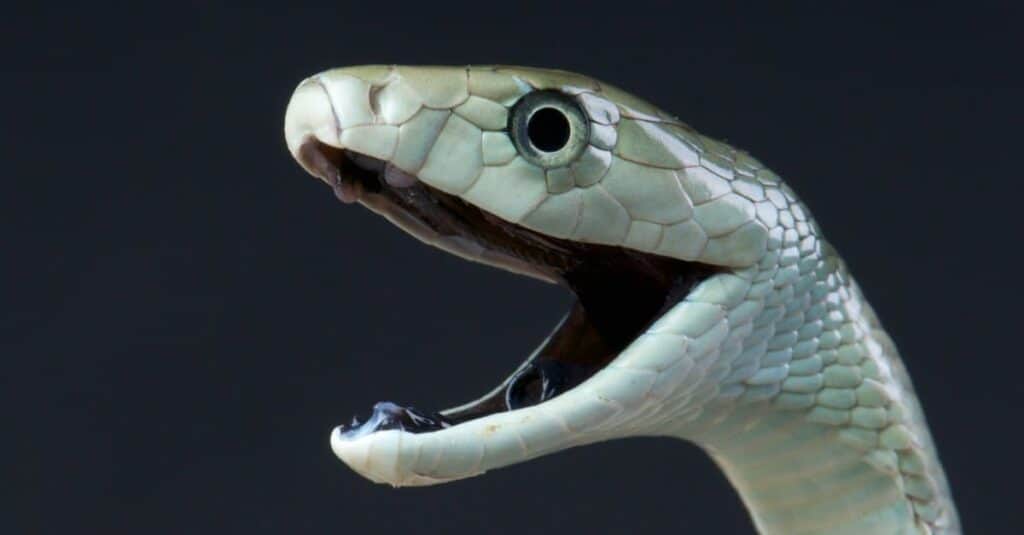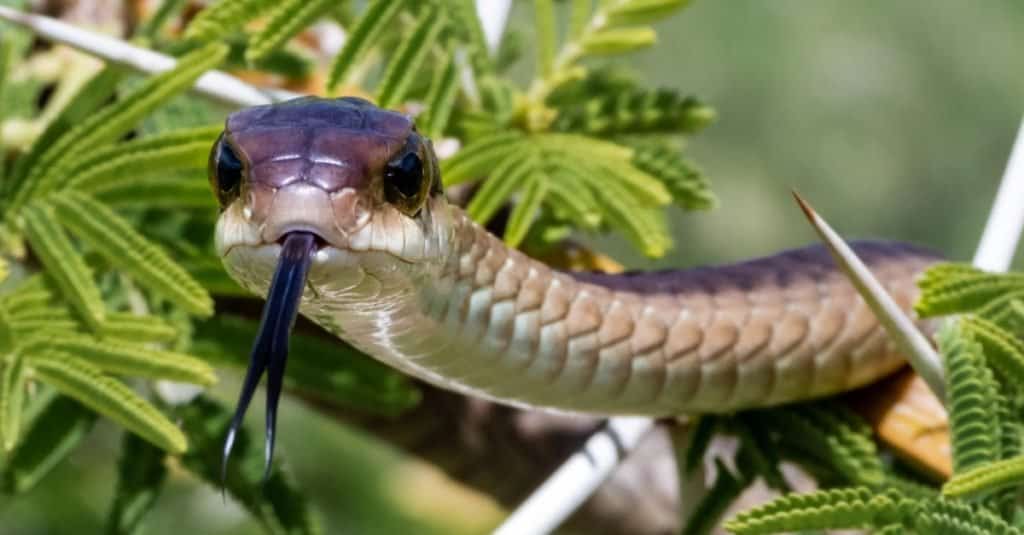The boomslang and the black mamba are native snakes to Sub-Saharan Africa. Black mambas are named after their black mouth, and boomslang snakes are commonly known as tree snakes. Both snake species are highly venomous, but they are not the same snakes. What then differentiates a boomslang from a black mamba? We’ll learn about their differences in this article.
Comparing a Boomslang and a Black Mamba

| Boomslang | Black Mamba | |
|---|---|---|
| Scientific Name | Family – Colubridae Genus – dispholidus Species – typus | Family – Elapidae Genus – Dendroapis Species – polylepis |
| Appearance | Long, slender snakes with pointed heads and large eyes | Long, slender snakes with elongated, coffin-shaped heads and medium-sized eyes |
| Distribution | Sub-Saharan Africa | Sub-Saharan Africa, especially eastern and southern Africa |
| Prey | Frog, eggs, rodents, birds, and small mammals | Bush babies, birds, mammals, and their young |
| Predator | Large birds and other snakes | Honey-badger, mongoose, and humans |
| Venom and Symptoms | Hemotoxic venom, causing internal and external bleeding and nausea | Neurotoxic venom, causing coma, delirium, seizures, and hemorrhagic swelling |
| Mating | Polygynandrous animals, mating between December and January | Polygynandrous animals, mating between September and February |
The Key Differences Between Boomslang Vs Black Mamba
The key differences between a boomslang and a black mamba are appearance, distribution, species, prey, and predator. Typically, a black mamba is shorter than a boomslang. While boomslangs belong to the Colubridae family, black mambas belong to the Elapidae family. But these are not all the main differences.
Let’s dive into their differences in detail.
Boomslang Vs Black Mamba: Scientific Name
Although the boomslang and black Mamba are deadly snakes that deliver lethal bites, they do not belong to the same family. Boomslang belongs to the family Colubridae, and it has the scientific name dispholidus typus. Although the Colubridae family consists of venomous and non-venomous snakes, the boomslang is the only surviving species of its genus.
On the other hand, the black mamba belongs to the family Elapidae, and it has the scientific name Dendroaspis polylepis. Other members of the family include the king cobras and the coral snakes.
Boomslang Vs Black Mamba: Appearance

Male boomslangs have a brown tint to their green bodies with black or blue outlines.
©iStock.com/FroeMic
The boomslang and black mamba are both long and slender. However, the black mamba is longer and has other distinct features. Identifying the boomslang should be pretty easy because of its distinctive appearance. Boomslangs have a long and slender body of up to six feet. These snakes have pointed heads with large eyes.
A male boomslang is quite different from the female in color – the male boomslang has a bright green color and a black or blue outline on its scales. In contrast, females have dark green bodies and brown bellies. Young boomslangs have gray skin, yellow throats, and black spots. They only achieve their adult coloration when they fully mature.
Similarly, the black mamba is also long and slender. However, this snake is about 9 feet long on a regular. A black mamba’s head is coffin-shaped and elongated, and it has medium-sized eyes with round pupils. Contrary to its name, the black mamba varies in color between light grey, dark grey, olive, or yellowish-brown. However, the inside of its mouth is black, earning it the name Black Mamba.
Boomslang Vs Black Mamba: Distribution
The boomslang and black mamba are native to sub-Saharan Africa. The boomslang is widely distributed throughout sub-Saharan Africa, especially in wooded grasslands and lowland forests. Boomslangs are common in countries like Botswana, Namibia, and Mozambique.
The black mamba is also distributed in sub-Saharan Africa. However, they are more common in eastern and southern Africa. Countries where you can find the black mamba include the democratic republic of Congo, South Africa, Namibia, Kenya, Uganda, and Cameroon.
Boomslang Vs Black Mamba: Prey

Black mambas are rarely black, and they’re actually named for the inside of their mouth.
©reptiles4all/Shutterstock.com
The boomslang bites and holds on to its prey while the black mamba releases its prey and waits until it is paralyzed or dies. Usually, boomslangs eat frogs, birds, eggs, and small mammals, including rodents. Boomslangs attack their prey, injecting venom and attacking the prey’s circulatory system. Because they can open their mouths wide up to about 170 degrees, boomslangs swallow their prey whole. Sometimes, when there is a lack of food, boomslangs eat each other.
The black mamba’s prey includes birds, bush babies, mammals, and other snakes. Sometimes, they eat their young. Black mambas bite their prey, and unlike boomslangs who hold on to their prey after biting, black mambas release theirs and wait till the prey succumbs to their venom. Like the boomslang, black mambas swallow their prey whole.
Boomslang Vs Black Mamba: Predator
The boomslang has more predators than the black mamba due to their relatively smaller size. In addition, the boomslang has several predators, including large birds like eagles, vultures, falcons, and other snakes. The primary predator of the black mamba are people who kill them out of fear. Other predators include honey badgers, black-headed herons, and mongooses.
Boomslang Vs Black Mamba: Venom and Symptoms

Female boomslangs are usually grey to brownish olive colored.
©Willem Van Zyl/Shutterstock.com
A boomslang’s venom is much slower than that of a black mamba. However, they are both deadly and can cause death.
Boomslangs have very potent hemotoxic venom that adversely impact the body’s circulatory system. When injected, this venom kicks in within 6 hours, affecting blood clotting and causing the victim to bleed internally and externally. Symptoms include drowsiness, nausea, and internal and external bleeding.
Black mambas are skittish snakes and prone to biting defensively. They often strike repeatedly and cause death in a short time. Their venom is neurotoxic, inducing symptoms in ten minutes. Symptoms include seizures, nausea, delirium, and coma. You will also experience hemorrhagic swelling, pain, and warmth on the snakebite site.
Boomslang Vs Black Mamba: Mating
The boomslang and black mamba are both polygynandrous. This means they may have multiple mates during mating season. They are also oviparous animals – they reproduce by laying eggs like birds. However, the boomslang has a shorter breeding period.
Boomslangs breeds between December and January. And as oviparous animals, a female boomslang can carry up to 30 eggs which it deposits in a hollow tree trunk or rotting log. The black mamba breeds between September and February. These snakes are also oviparous, carrying between 6 and 17 eggs.
The photo featured at the top of this post is © Andre Coetzer/Shutterstock.com
Discover the "Monster" Snake 5X Bigger than an Anaconda
Every day A-Z Animals sends out some of the most incredible facts in the world from our free newsletter. Want to discover the 10 most beautiful snakes in the world, a "snake island" where you're never more than 3 feet from danger, or a "monster" snake 5X larger than an anaconda? Then sign up right now and you'll start receiving our daily newsletter absolutely free.
Thank you for reading! Have some feedback for us? Contact the AZ Animals editorial team.







